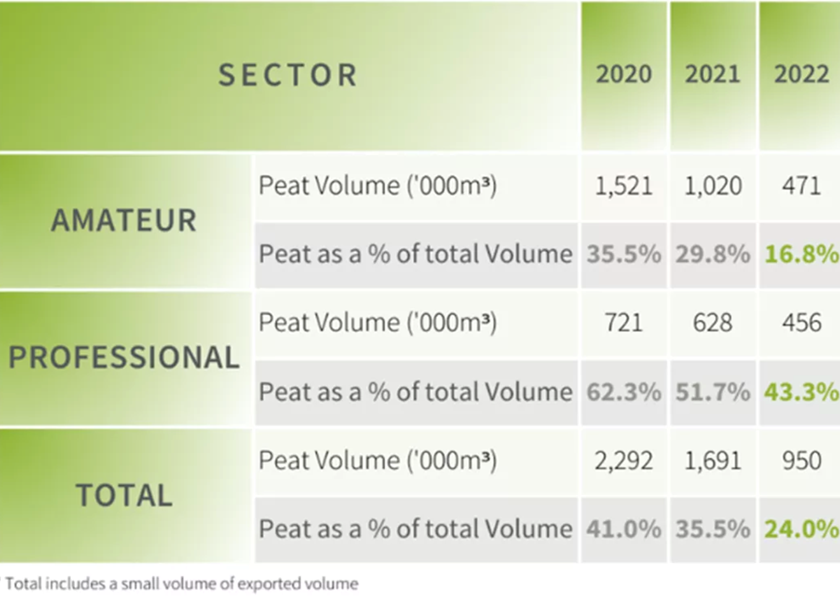The latest Growing Media Monitor report details horticulture’s progress to peat-free
The latest Growing Media Monitor report highlights the horticulture industry's dedication to becoming peat-free.

The latest Growing Media Monitor report highlights the horticulture industry's dedication to becoming peat-free.
Based on 2022 data, the report, which is developed annually by the Horticultural Trades Association (HTA) and its specialist group, the Growing Media Association (GMA), the Agriculture and Horticulture Development Board (AHDB), and the Department of Environment Food and Rural Affairs (DEFRA), demonstrates a hugely positive shift towards more sustainable practices within the sector.
Key findings of the report reveal a significant decline in the proportion of peat used in environmental horticulture. In 2022, peat accounted for only 24% of the total volume of growing media, compared to 36% in 2021. The retail industry has shown remarkable voluntary progress in using less than half the volume of peat compared to the previous year. The percentage now stands at just 16.8% and is rapidly declining. This decrease is attributed to the collaborative efforts of UK suppliers, growers, and retailers in adopting peat-free practices.
Retailers have been increasingly specifying peat-free products, while manufacturers have improved their proficiency in producing viable alternatives. For the first time, the proportion of peat used in professional growing media fell below 50% in 2022, reaching 43.3%. Additionally, growing media used to produce nursery stock, pot or bedding plants suggests that roughly 16% of the professional commercial-scale production of trees and plants took place in peat-free products in 2022. The equivalent figure in 2021 was 8%, meaning peat-free production has doubled in the last year. This downward trend in peat usage reflects the industry's commitment to successfully transitioning to a peat-free future by the end of the decade. However, the report also highlights the complexity and difficulty of reducing the remaining 43% in professional use.
Wood-based materials, such as wood fibres derived from wood chips, have become the most voluminous ingredient in growing media, accounting for 35.5% of the volume of products supplied to the retail sector. Other alternatives, including bark, coir, and organic materials, have also increased, replacing the peat in the supply chain. However, the figures also indicate some challenges around consistency and vulnerabilities in the supply chain of peat alternatives for UK growing media. The report reflects some of the technical challenges manufacturers face in developing reliably performing mixes for specific types of plants and gardening purposes, such as specialist products for ericaceous plants. Importantly, 85% of finished ornamentals rely on peat to some extent.
James Barnes, Chairman of the HTA, expressed support for the industry's progress, stating,
"These results show the momentum of our industry in moving away from peat. The use of peat is dropping each year thanks to the dedication and hard work of the sector in working together and sharing knowledge from research and trialling suitable alternatives. But, we need support to get to the finish line in ensuring a successful and sustainable transition to peat-free practices without unintended consequences for horticulture and the environment.
“A scenario in which reductions in peat use by UK growers are offset by increased imports of plants produced in peat at lower cost and/or higher yield from overseas growers would effectively be offshoring the UK's peat use and damaging to UK horticulture and the economy. The horticulture and landscaping industry in the UK plays a vital role in the economy, contributing £28.8 billion to the GDP and supporting around 1 in 54 jobs in the UK economy.
“While the report showcases substantial progress in reducing peat usage, challenges remain to continue the momentum in removing peat from supply to retail whilst still satisfying consumer demand for gardening. Challenges such as lengthier supply chains for alternatives like coir contribute to increased costs in the supply chain. The industry needs sufficient access to alternative materials and the capacity to process them to meet growing demand. Failure to address these challenges may result in supply shortages and price inflation in the coming years."
Environment Minister Trudy Harrison said:
“It is great to see that suppliers, growers and retailers are continuing to work together alongside Government to decrease the use of peat across the horticulture sector.
“I am strongly encouraged by the steps which the sector is taking to increase the use of peat alternatives, such as bark and bracken and we will continue to provide support to the sector as the industry continues its journey to becoming peat free.”
The report underlines the importance of further research and development into peat-free and reduced-peat mixes to ensure a sustainable transition.
The horticulture and landscaping industry plays a vital role in the UK economy, and access to high-quality growing media is essential for its success. Achieving a peat-free future is within our grasp, provided the right support, is in place.
